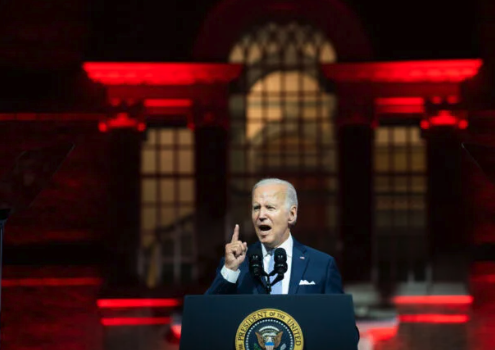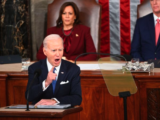Politics and the Environment –
By Glynn Wilson –
WASHINGTON, D.C. — In sharp contrast to the previous administration in Washington, and in spite of some compromises on domestic oil and gas production in Alaska and the Gulf of Mexico that angered environmentalists, it is important to report on this Earth Day 2023 that the Biden administration has done more for protecting the environment and fighting global warming and climate change than any administration in American history.
Politics is sometimes the art of compromise, but it would be hard to imagine a more pro-environment and progressive agenda than pushed hard by this president.
On a regular basis over the past year and a half, the Biden administration has announced one new environmental initiative after another, most recently rolling out the most ambitious federal vehicle emissions standards ever that will accelerate the ongoing transition to a clean vehicles future by requiring that two-thirds of new passenger cars and a quarter of new heavy trucks sold in the United States are all-electric by 2032. If the two rules are enacted as proposed, they would put the world’s largest economy on track to slash its planet-warming emissions at the pace that scientists say is required of all nations in order to avert the most devastating impacts of climate change, and it would be nothing short of a revolution in the U.S. auto industry.
The announcement came from the Environmental Protection Agency (EPA), which says the new, tougher regulations would improve air quality for communities across the nation, especially poor, minority communities that have borne the brunt of polluted air for decades. When implemented, the rules would help the U.S. avoid nearly 10 billion tons of CO2 emissions, equivalent to more than twice the total U.S. CO2 emissions in 2022, while saving thousands of dollars over the lives of the vehicles meeting these new standards and reduce America’s reliance on approximately 20 billion barrels of oil imports.
Biden Administration Proposes Tough New Pollution Standards for Cars and Trucks
The Biden administration also recently released a set of proposed new pollution standards to update the Mercury and Air Toxics Standards for coal-fired power plants, advancing tougher requirements to reduce hazardous air pollutant ion emissions and further public health protections for the public, especially children and vulnerable segments of the population such as Indigenous communities, low-income communities and people of color who live near power plants.
Biden Administration Proposes Stronger Mercury and Air Toxic Standards for Power Plants
In a press release touting other achievements, the administration announced new actions to conserve, restore, and expand access to public lands and waters, to modernize the management of America’s public lands, a plan to harness the power of the ocean to fight the climate crisis, a strategy to better conserve wildlife corridors, and new funding to improve access to outdoor recreation, promote Tribal conservation, reduce wildfire risks and more.
This is also showing up in public opinion data, as at least Democrats are encouraged by the direction of public policy in Washington.
Global Warming’s Effects Have Begun: Only 60 Percent of Americans Believe It
“During his first year in office, President Biden protected more lands and waters than any president since John F. Kennedy,” the White House says.
This included restoring protections for Bears Ears, Grand Staircase-Escalante, and Northeast Canyons and Seamounts National Monuments protected by the Obama administration, but rolled back by Trump.
“Thanks to the President’s Bipartisan Infrastructure Law and the Inflation Reduction Act, President Biden has, over his first two years in office, invested over $10 billion in conservation initiatives – more than any other modern president,” the White House says.
“Under the President’s leadership, the administration is making unprecedented investments in land, water, and wildlife conservation, including … launching the $1 billion America the Beautiful Challenge. These investments will help meet the President’s goal — set during his first week in office — of conserving at least 30 percent of U.S. lands and waters by 2030.”
This is not insignificant, and the public is encouraged by the action, as public opinion polls show.
The Biden administration has protected nationally-significant lands and waters across the country, including recent actions to restore protections for roadless areas of the Tongass National Forest, prevent future oil and gas leasing in the entire U.S. Arctic Ocean, safeguard Bristol Bay in Alaska and the world-class salmon fishery it supports, and protect America’s most-visited wilderness area, the Boundary Waters in Minnesota.
The Administration is also working to protect Chaco Canyon in New Mexico, the Thompson Divide in Colorado, and accelerating restoration efforts in the Great Lakes, the Chesapeake Bay, the Everglades, and the Columbia River Basin.
The president is also directing the Secretary of Commerce to consider exercising her authority to protect all U.S. waters around the Pacific Remote Islands.
“These new commitments build on President Biden’s historic climate and environmental record, including delivering on the most ambitious land and water conservation agenda in American history,” the White House says.
Also, the Ocean Policy Committee, co-chaired by the White House Council on Environmental Quality and the White House Office of Science and Technology Policy, is releasing the first-ever United States Ocean Climate Action Plan, a groundbreaking roadmap to harness the power of the ocean to advance immediate, transformational steps to protect ocean health and address the climate crisis.
Acknowledging that there is no path to a healthy and livable climate without the ocean, the plan outlines new actions on the administration’s ocean-climate priorities, including efforts to advance climate solutions, promote environmental justice, support healthy communities and ensure a robust and sustainable ocean economy.
The White House Council on Environmental Quality is issuing new guidance to federal agencies on how to better incorporate ecological connectivity and wildlife corridors into federal planning and decision-making. The guidance highlights the importance of connectivity across terrestrial, marine, and freshwater habitats, encouraging collaboration across management and ownership boundaries with states, Tribes, local governments, and private land owners. This helps deliver on one of the America the Beautiful Initiative’s six early focus areas – supporting collaborative conservation of fish and wildlife habitat and corridors.
The Department of the Interior’s Bureau of Land Management will, in the coming weeks, seek public input on a proposed rule that will help update and modernize the agency’s tools and strategies for managing America’s public lands. With climate change imposing mounting impacts on the nation’s public lands, and the growing importance of public lands for recreation and conservation, the proposed rule would help ensure that the nation’s lands continue to provide abundant and well-connected wildlife habitat, supply clean drinking water, and power local economies.
The Department of the Interior and the Department of Defense are partnering to allocate $80 million through a combination of the Land and Water Conservation Fund (LWCF) and matching funds from DoD’s Readiness and Environmental Protection Integration Program (REPI) to preserve green space around military installations and improve access to outdoor recreation for millions of Americans. The Departments will make the funding available to states through a competitive process that could support projects on Tribal, private, state, or local lands.
Native Americans in Philanthropy, in collaboration with Biodiversity Funders Group and 15 philanthropies, is launching the Tribal Nations Conservation Pledge with an initial commitment of more than $100 million. This is a new platform for philanthropic organizations to support the conservation work of Tribal Nations and public-private partnerships between the Biden-Harris Administration, Tribes, and philanthropy. The pledge calls on funders to commit to a self-determined amount of funding, or a self-determined percentage of annual programmatic funding, to support the biodiversity and conservation efforts of Tribes, inter-Tribal organizations, and Tribal consortia.
The Biden administration is releasing the 2022 America the Beautiful Annual Report, an update on progress made to support locally-led conservation and restoration efforts and meet the President’s goal to conserve at least 30 percent of U.S. lands and waters by 2030.
The Department of the Interior’s U.S. Fish and Wildlife Service, National Alliance of Forest Owners and the National Council for Air and Stream Improvement Inc., will announce a memorandum of understanding which formalizes the Wildlife Conservation Initiative, a collaborative partnership focused on advancing the conservation of at-risk and listed species within private working forests nationwide. The announcement comes as the Department of the Interior celebrates the 50th anniversary of the Endangered Species Act and highlights the landmark law’s importance in preventing imperiled species’ extinction, promoting the recovery of wildlife, and conserving the habitats upon which they depend.
Soon the Federal Highway Administration and the Department of Transportation will open applications for the first-of-its-kind $350 million Wildlife Crossings Pilot Program. The program will build infrastructure that is proven to improve roadway safety – particularly in rural communities – and bring down the roughly 200 deaths stemming from more than one million collisions every year between vehicles and wildlife.
The U.S. Department of Agriculture’s Forest Service announced nearly $200 million in Community Wildfire Defense Grant (CWDG) program grants to communities across the country. Funded by President Biden’s Bipartisan Infrastructure Law, the CWDG program is designed to assist communities, including Tribal communities, non-profit organizations, state forestry agencies and Alaska Native corporations with planning for and mitigating wildfire risks to communities and critical infrastructure as the nation faces an ongoing wildfire crisis.
The U.S. Fish and Wildlife Service is distributing over $56 million for state fish and wildlife agencies through the State Wildlife Grant Program to support conservation and stewardship efforts for imperiled wildlife and their habitats.
The U.S. Fish and Wildlife Service is distributing over $20 million in grant funding to assist states and territories in the construction, renovation and maintenance of marinas and other boating facilities for outdoor recreation. Grants will support projects in 20 states, Puerto Rico and the U.S. Virgin Islands to increase outdoor recreation access and waterway stewardship.
The U.S. Forest Service and the Bureau of Land Management announced actions to consider protections for cultural and natural resources in the Pactola Reservoir – Rapid Creek Watershed in South Dakota, including drinking water for Rapid City and Ellsworth Air Force Base, from the adverse impacts of mineral exploration and development. The Pactola Reservoir is the largest and deepest reservoir in the Black Hills National Forest, with 14 miles of shoreline and 150-foot depths on 800 acres and provides high quality recreation for communities and visitors.
It is hard to imagine any other administration taking such a comprehensive and forward-looking approach to protecting the natural environment and working on plans to combat climate change due to global warming from the burning of fossil fuels for energy and transportation. Hopefully the American people will remain onboard to keep this progress going beyond 2024.
___
If you support truth in reporting with no paywall, and fearless writing with no popup ads or sponsored content, consider making a contribution today with GoFundMe or Patreon or PayPal. We just tell it like it is, no sensational clickbait or pretentious BS.
Before you continue, I’d like to ask if you could support our independent journalism as we head into one of the most critical news periods of our time in 2024.
The New American Journal is deeply dedicated to uncovering the escalating threats to our democracy and holding those in power accountable. With a turbulent presidential race and the possibility of an even more extreme Trump presidency on the horizon, the need for independent, credible journalism that emphasizes the importance of the upcoming election for our nation and planet has never been greater.
However, a small group of billionaire owners control a significant portion of the information that reaches the public. We are different. We don’t have a billionaire owner or shareholders. Our journalism is created to serve the public interest, not to generate profit. Unlike much of the U.S. media, which often falls into the trap of false equivalence in the name of neutrality, we strive to highlight the lies of powerful individuals and institutions, showing how misinformation and demagoguery can harm democracy.
Our journalists provide context, investigate, and bring to light the critical stories of our time, from election integrity threats to the worsening climate crisis and complex international conflicts. As a news organization with a strong voice, we offer a unique, outsider perspective that is often missing in American media.
Thanks to our unique reader-supported model, you can access the New American journal without encountering a paywall. This is possible because of readers like you. Your support keeps us independent, free from external influences, and accessible to everyone, regardless of their ability to pay for news.
Please help if you can.
American journalists need your help more than ever as forces amass against the free press and democracy itself. We must not let the crypto-fascists and the AI bots take over.
See the latest GoFundMe campaign here or click on this image.
Don't forget to listen to the new song and video.
Just because we are not featured on cable TV news talk shows, or TikTok videos, does not mean we are not getting out there in search engines and social media sites. We consistently get over a million hits a month.
Click to Advertise Here
















